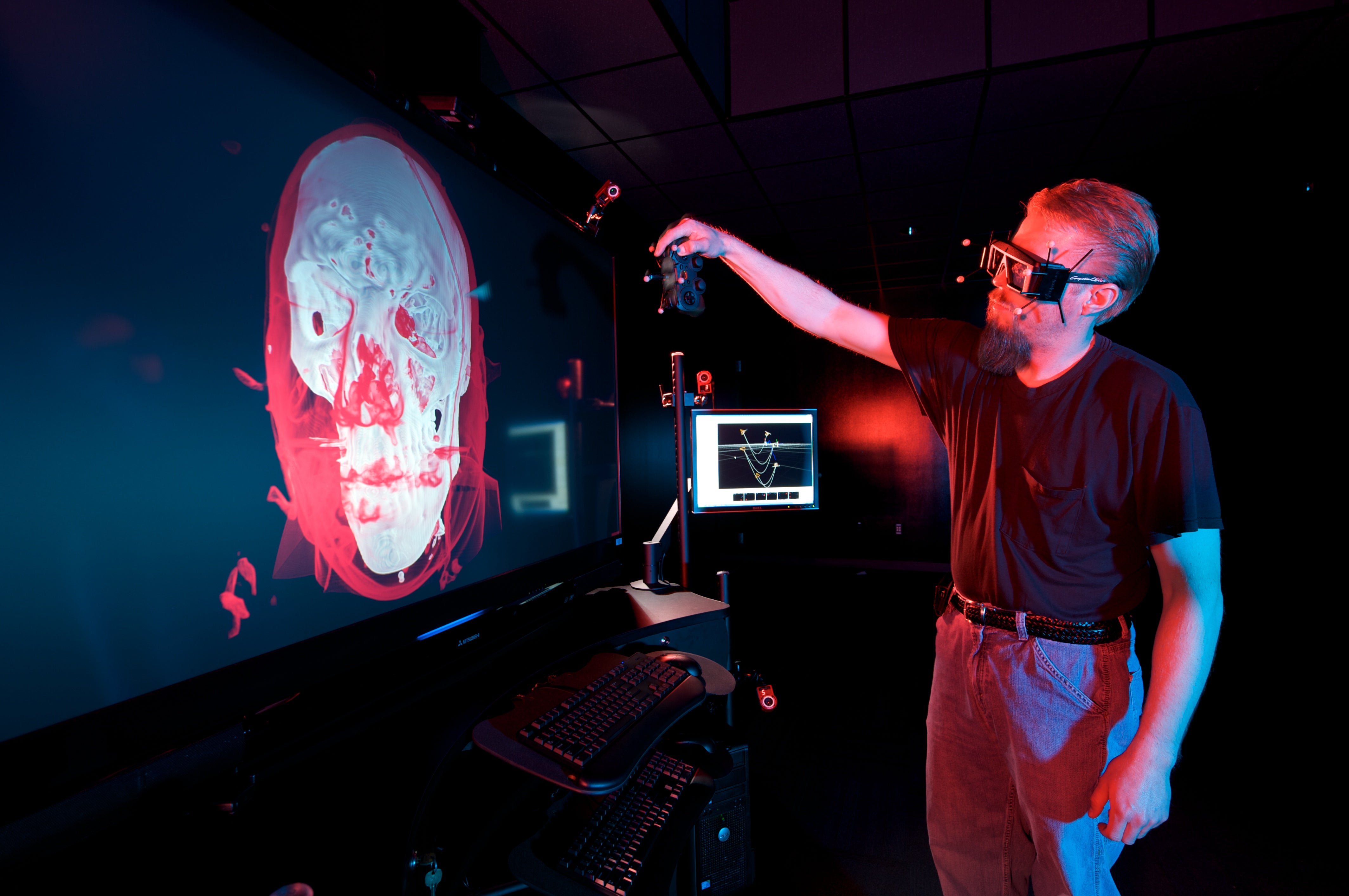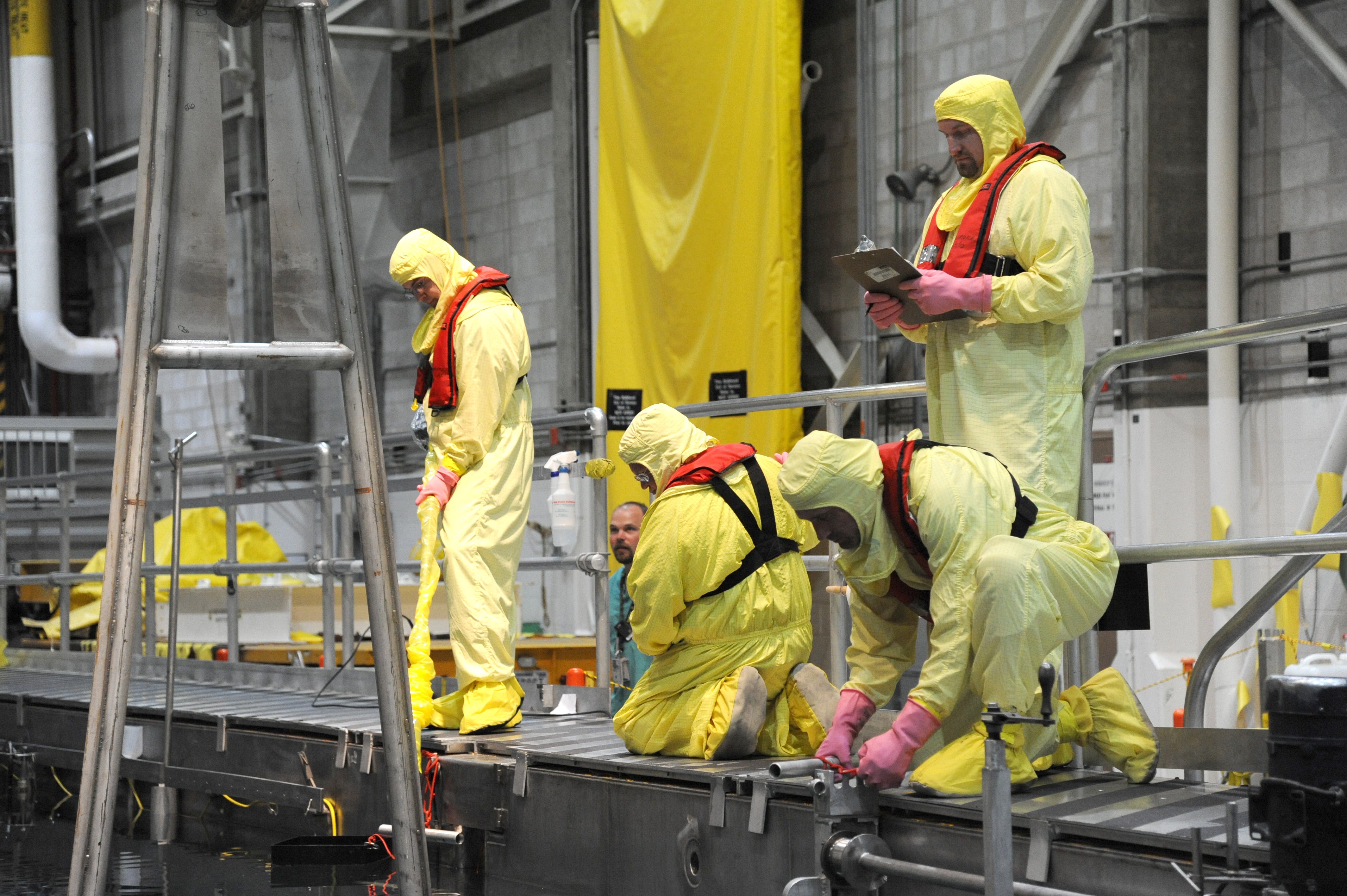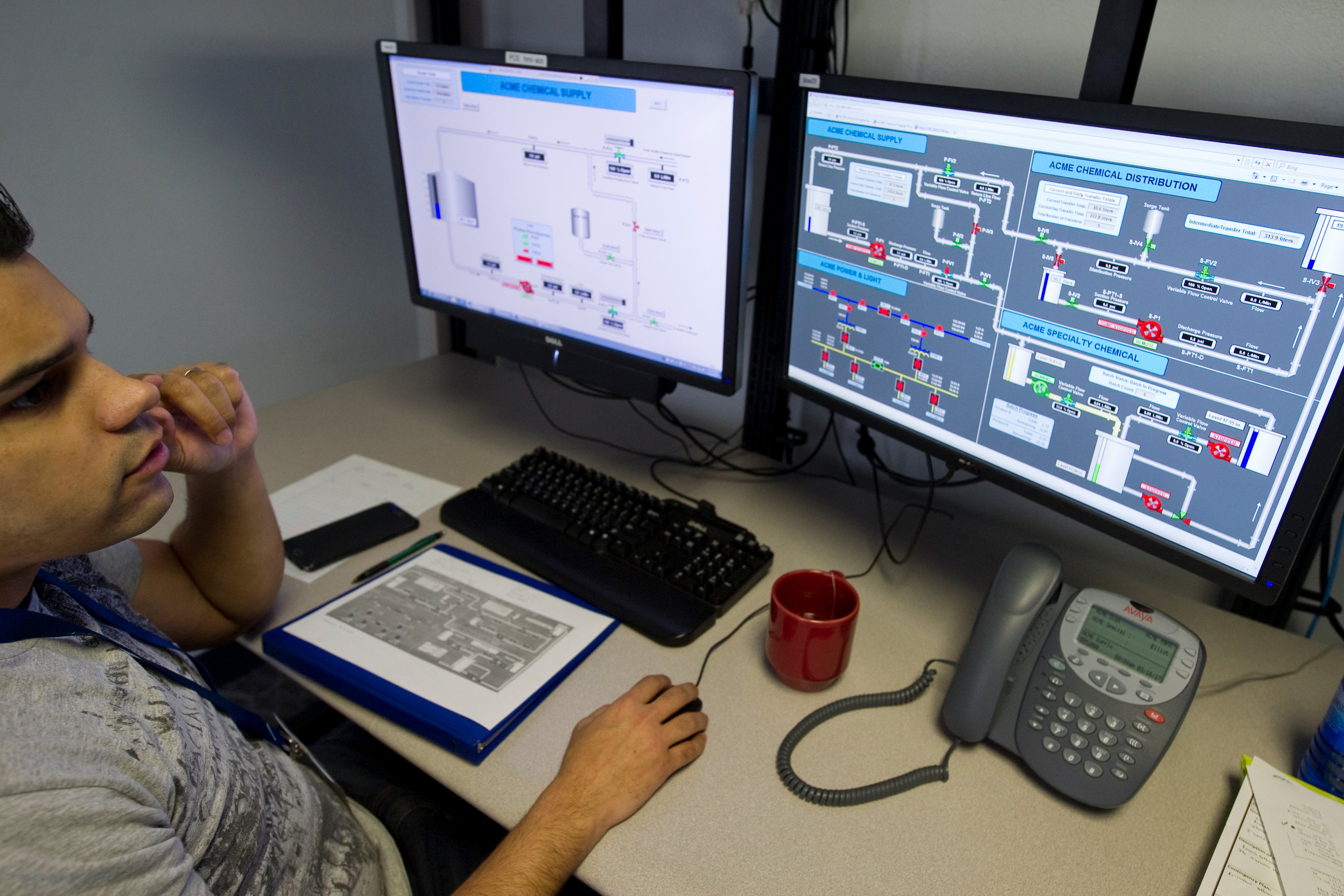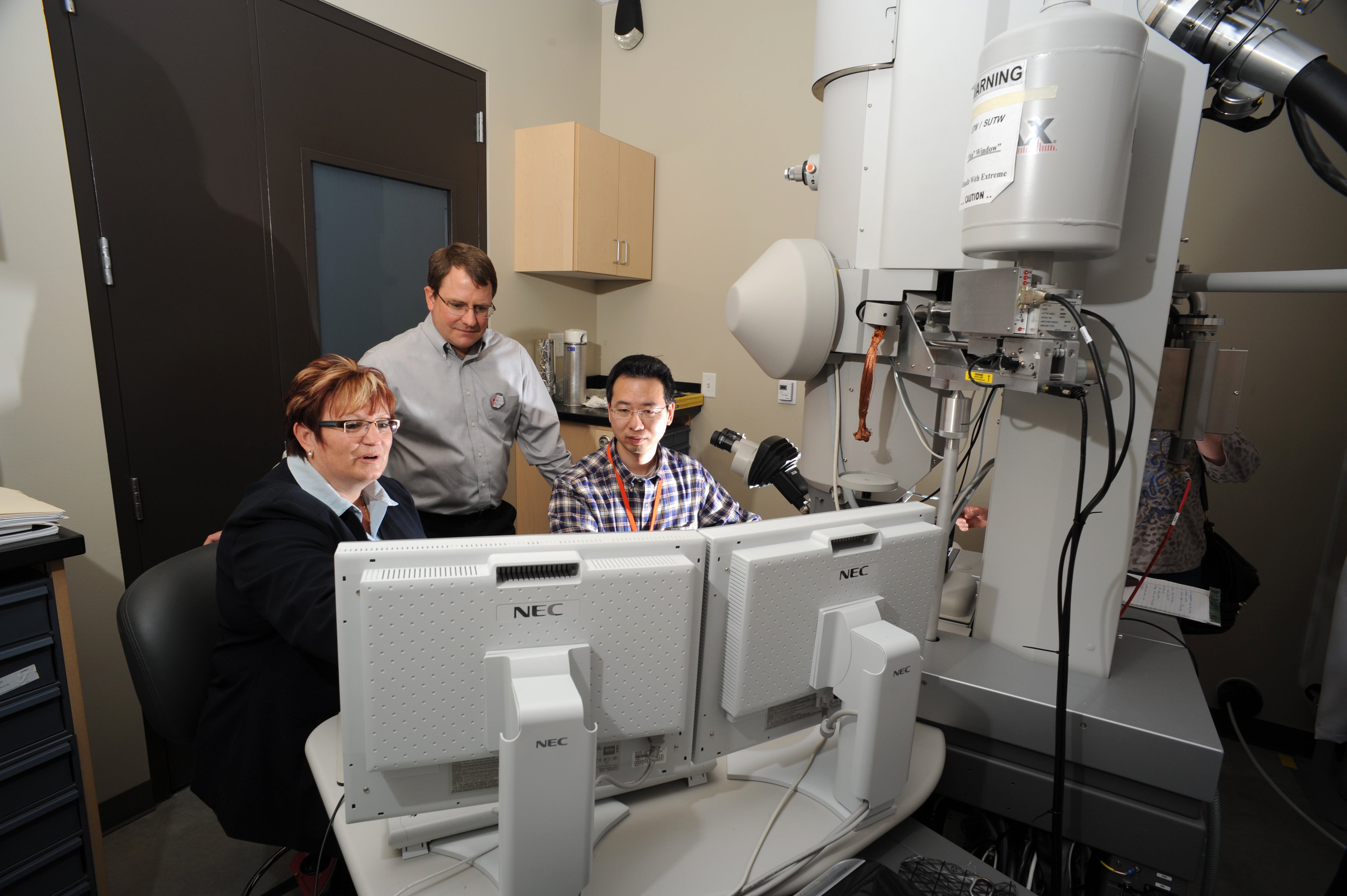Boise State’s second annual Research Month is April 2018. Research Month celebrates the diverse and fascinating array of research happening each day on campus.
In 2016, Boise State University earned its aspirational tagline – becoming a metropolitan research university of distinction – when the Carnegie Classification of Institutions of Higher Education named Boise State as a doctoral research institution. Less well known, though no less celebrated, is the way the university built up its significant research reputation through partnerships forged at the Center for Advanced Energy Studies (CAES).

Opened in 2009, CAES is a research and education consortium bringing together Boise State University, Idaho State University, the University of Idaho, the University of Wyoming and the Idaho National Laboratory (INL) – a national laboratory dedicated to supporting the Department of Energy’s (DOE) efforts in nuclear science, renewable energy and national security.
“CAES is the portal and the gateway to collaborations across participating institutions,” explained Amy Moll, associate CAES director and a professor in the Micron School of Materials Science and Engineering. “For Boise State, it’s the entry point for our researchers and our students to work with INL. The consortium is also a terrific way to partner with the other academic institutions on energy projects important to private industry.”
Headquartered on the banks of the Snake River in Idaho Falls, the CAES main campus is situated near INL. Yet, CAES research is conducted at all five affiliated institutions creating a truly collaborative hub-and-spoke model.
“CAES helps pool resources and brings universities together that otherwise might not have the facilities to execute the kind of research they want,” added Brian Jaques, an assistant research professor in the Micron School of Materials Science and Engineering, and frequent CAES collaborator.
In 2017, CAES spent $788,308 on laboratory-directed research and development; it published 130 research articles and proceedings; and 76 students from CAES-affiliated universities were hired as INL or CAES interns in areas including nuclear engineering, biological sciences, computer science and mechanical engineering.
The impact CAES has had on Boise State faculty and student research alone cannot be overstated. Through faculty and student collaborations at CAES, Boise State has become a leader for materials science in nuclear energy; in 2017 Boise State researchers were awarded over $1.6 million in DOE nuclear energy research funding through CAES collaborations. In addition, research conducted at CAES has influenced policy both within the state of Idaho and beyond. For example, the CAES Energy Policy Institute, located at Boise State, currently is working with the Leadership in Nuclear Energy Commission to produce user-friendly briefs on nuclear material storage and disposition, and has conducted important economic studies supporting the development of small modular reactors.
“CAES has become a very valuable part of the Boise State research experience,” said Harold Blackman, the associate vice president of research at the university. “Within the last three years especially, because of the relationships we’ve built through CAES, other programs have started outside the formal CAES consortium and are now significant contributors to that consortium.”
Below is a brief look at how Boise State research is helping to solve our nation’s critical problems in energy and cybersecurity, through collaborations with CAES and INL.
In-Pile Instrumentation

Documenting the reactions that take place inside an active nuclear reactor is incredibly tough – high temperatures, corrosion, pressure, fission gas production, microstructure and cracks (among other things) make accurate data collection difficult. For this reason, Boise State and INL began developing advanced sensor technology designed specifically to withstand the harsh conditions inside reactors and advanced reactors, thanks to the In-Pile instrumentation initiative, a collaboration between INL, Boise State and the University of Notre Dame. The $5 million, two-year initiative was funded through the DOE’s Nuclear Energy Enabling Technology and Nuclear Science User Facilities programs.
“Our researchers are working on instruments that can be put inside of a core and withstand the harsh environment, provide data and eventually provide information that allows us to run the reactors more efficiently,” Blackman explained.
“This is an example of the type of collaborative projects CAES has opened up for us,” Moll said. “We have graduate students and undergrads involved on this, there are probably 50 people involved, including INL staff and Boise State.”
Boise State has long been a leader in materials science research, and in recent years, that strength has homed in on nuclear energy research, thanks to collaborations within CAES and INL.
“We started with a network between University of Idaho and the INL, but we’ve been able to build networks nationally thanks to our initial collaboration,” said Jaques, whose research group includes two Boise State staff members and 12 graduate and undergraduate students. “We hosted a planning meeting last summer with 35 individuals from national labs and institutions, who were there to speak about research for modeling, simulations and materials for extreme environments.”
The lab experience is especially invaluable to graduate and undergraduate students, where they are exposed to state-of-the-art instrumentation, as well as being exposed to and mentored by talented researchers. While Boise State has an advanced materials laboratory on campus, Jaques explained that sending students to Idaho Falls to use the CAES facilities is common.
“Students use the experience as an opportunity to see a bigger picture of their research impact instead of focusing on a narrow mindset,” Jaques said. “For instance, if they get in early with researchers and people making decisions on the vision and direction of these big initiatives, these students (and their advisors) can try and make their research relevant to that direction, that vision. CAES allows for a lot of interactions – students can work with INL folks, University of Idaho, University of Wyoming and Idaho State University students and researchers. We develop the talent with the vision, and it opens doors when they graduate.”
Cyber Security
Recent media reports on the threat of Russian hackers gaining control of U.S. power and energy grids has only underscored the urgent need for well-developed cyber security measures. It is nationally imperative to protect these grids, as well as large-scale manufacturing systems, dams, transportation systems and early warning systems.

The problem is that much of the technology governing critical physical systems like dams was developed in the ’60s-’80s. These control systems often were designed using new at the time control and network technologies, but were not designed with cybersecurity controls in mind because digital threats were not yet recognized as a potential problem.
Fortunately, INL’s National and Homeland Security directorate has joined with Boise State’s College of Engineering to develop curriculum in this area.
“The staff at INL already are recognized worldwide experts in cybersecurity of physical systems,” said Rex Oxford, assistant dean for research and infrastructure in the College of Engineering. “INL is extremely interested in having programs that will train students so that there’s a trained workforce that has expertise in physical cybersecurity.”
In 2017, Boise State received state funding to establish a cybersecurity research and instruction lab. The lab, which is located in downtown Boise, has both an industrial scale process control and simulation system, and smart grid control hardware similar to that found in the control rooms of your local electrical company. These labs will provide hands-on opportunities for student training, and also be used for research investigations.
Oxford says curriculum is being developed for a certification program, as well as eventual undergraduate and graduate programs. The certification program, which is set to launch fall 2018, not only will focus on prevention, but designing new systems with enhanced safety features that are less vulnerable to hacking. The multidisciplinary program includes faculty from Boise State’s computer science, electrical and mechanical engineering, and mathematics departments.
“We will have a certificate program in the cybersecurity of physical systems that will be accessible for students who are in electrical engineering, mechanical engineering, physics and mathematics,” Oxford said. “We’re trying to allow students from a wide variety of backgrounds to gain expertise in these security systems, as cybersecurity of physical systems is not just a software issue – you can impact control systems through a wide variety of means, not just hacking into a network.”
Throughout the process, Oxford says INL has been involved in all stages – from reviewing equipment for the cybersecurity lab to working on curriculum design. In fact, Oxford says INL staff have requested video conferencing capabilities in the lab so that INL engineers can deliver lectures from Idaho Falls.
“We have developed an enriched relationship that has gone beyond CAES, and in turn, it’s changing CAES,” Blackman said. “Now CAES is talking about cybersecurity as something they’d consider, as it has an impact on our nation’s ability to provide reliable power.”
In February, CAES brought together university faculty, staff, and students from its four universities to meet with INL researchers conducting national security work. The two-day collaborative meeting was the launch point to a new CAES focus area aimed at increasing the talent pipeline of cyber professionals.
Microscopy and Characterization Suite (MaCS)

Ambitious research often is constrained by the limits of mediocre or out-of-date technology. Such is not the case at the Microscopy and Characterization Suite (MaCS), a state-of-the-art lab and user facility at CAES headquarters that is designed to allow researchers to explore radiological and non-radiological materials and delve into these materials at the atomic level.
“The lab is a powerful resource for faculty,” explained Yaqiao Wu, director of the MaCS facility. In it, researchers are able to characterize a wide range of materials including semiconductors, metals, ceramics, coal, minerals and even cellular organic materials. With the advanced instruments, i.e., STEM, LEAP, FIB/SEM, Nanoindenter/AFM and XRD, MaCS can provide microstructures in both 2D and 3D morphology, materials’ chemical information and mechanical testing data from micron to atomic scale.
Based on atom probe tomography (APT) technique, the unique local electrode atomic probe (so-called LEAP), at MaCS, gives truly atom’s identity and its position in real 3D space, which allows researchers around the world to accurately locate atoms’ space distribution and do quantitative analysis. The LEAP at MaCS is the only one of its kind in Idaho, and there were only six of the same kind in the world at the time when it was built. Wu said.
This is just a sample of the fascinating research and opportunities open to Boise State faculty and students, thanks to CAES and the partnerships forged within it. Through it all, collaboration has been the key to success.
“These partnerships, and collaborations are spawning new ideas and better science and engineering while contributing to the education of our students,” Blackman said. “It’s been excited to see and we’re all eager for it to continue.”